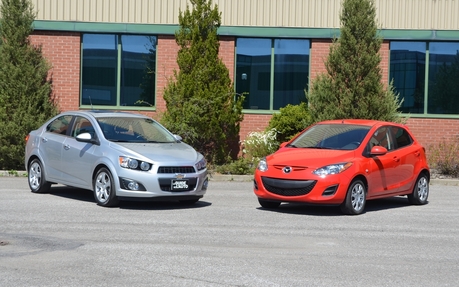Mazda2 vs. Chevrolet Sonic: Two subcompacts go head to head
In Quebec, the subcompact car market is considerable, as buyers have a real appetite for affordable, fuel-efficient cars. So it’s no surprise that many automakers achieve their best sales figures in this category in la Belle Province. Mazda is a relative newcomer to this segment, as it only decided to offer the Mazda2 in Canada in 2011. Meanwhile, Chevrolet is offering us the Sonic this year, instead of the Aveo – not exactly the manufacturer’s most impressive model. It seems that GM is still having trouble concocting a winning recipe in this category.
GM gets the nod for its configurations
For the purposes of this comparison, we played the versatility card by pitting a sedan against a hatchback. In an effort to win over the largest number of buyers possible and meet various needs, most manufacturers offer two versions of their subcompacts: a four-door sedan and a hatchback. While the Mazda2 comes only in a hatchback, GM offers the Sonic in two versions and, as is often the case, the wagon is much better looking. The Sonic’s signature style hinges mainly on its front end with oversized circular headlights and some very nice rims on some versions, which make it more dynamic. It is, without a doubt, GM’s most stylish subcompact.
The Mazda2 was designed to look dynamic, in keeping with its family DNA. We like its plunging hood and raised tailend, and the air intake under the front grille creates that classic Mazda smile. The Mazda2 features a patently more youthful style, which is ironic when you consider that Sonic buyers will be younger than the average GM buyer.
At 4,399 mm, the Sonic is a little longer than the Mazda2 (3,950 mm), and the same goes for height, too. These two cars are similarly priced: $14,095 for the Mazda2 and $14,495 for the Sonic – though you have a broader selection of equipment on the Sonic. In any case, you can get either of them suitably equipped.
Pros and cons
Longer and taller, it stands to reason that the Sonic has more room for its passengers and is therefore better for those who want superior comfort. As for the driving position, the Sonic’s seats meet European standards, while the Japanese Mazda2 has a lower seat. We liked the fact that the Sonic has an armrest. But its rival distinguished itself with more enveloping seats and more versatile storage compartments in the central console.
Once criticized for its dull and poor quality passenger compartments, GM did a good job inside the Sonic. It’s much more modern, thanks to excellent lighting and a motorcycle-inspired instrumentation design. The Mazda2’s dashboard is much more rudimentary, but we liked its simplicity and careful ergonomics. Despite appearances, ¾ rear visibility is better in the Japanese car is better, since the large C-pillar (between the rear windows and the hatch) blocks your view on the Sonic.
Since many people have family needs to contend with, loading capacity remains an important feature. The Sonic hatchback’s trunk isn’t the biggest in the category, but it has a nice finish and the back seats create a flat surface when lowered. The floor can be removed to add precious litres of cargo space. The sedan we tested had a surprisingly spacious trunk considering the size of the car. It offers a 396-litre capacity, while the Mazda2 varies from 377 to 787 litres, depending on the position of the rear seats. Of course, the Mazda2’s trunk is more practical as the hatch opening is bigger.
More power thanks to turbocharging
The Mazda has just one engine, a 1.5-litre four-cylinder that produces 100 horses and 98 lbs-ft of torque. Power is transmitted to the front wheels using a factory standard five-speed manual transmission or an optional four-speed automatic.
The Chevy comes with one of two engines, depending on the trim level you choose. The base version comes with a 1.8-litre four-cylinder with 138 horsepower and 125 lbs-ft of torque paired factory standard to a five-speed manual gearbox. The higher end versions are equipped with a 1.4-litre four-cylinder turbo that also deploys 138 horses, but offers a much more generous 148 lbs-ft of torque. This engine is paired with a six-speed manual transmission instead of a five-speed.
As for performance, the lighter Mazda2 is a little livelier during initial accelerations, but the turbocharged Sonic storms back with its pick up, thanks to its superior torque. The Mazda2 is the more fuel efficient of the two with an average of 7.5 L/100 km versus 8.8 L/100 km.
The Mazda2’s independent suspension is well balanced while the Sonic’s – a rear semi-independent suspension – is a little harsher, which could disappoint fans of a sportier ride.
The last word
This comparison was carried out with the help of my colleague Gilles Olivier. In his opinion, these are two very different cars, and it’s not a simple question of sedan versus hatchback. Despite its less powerful engine, the Mazda2 is more pleasant to drive while the Sonic will manage to reach a broader clientele thanks to is different configurations and broader equipment options.
